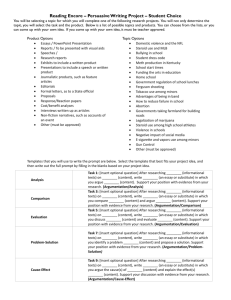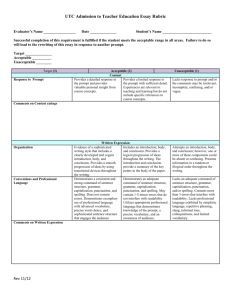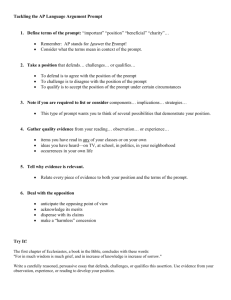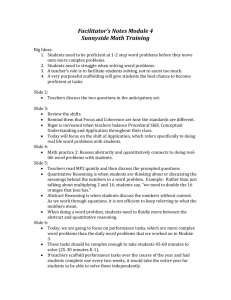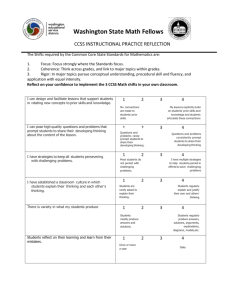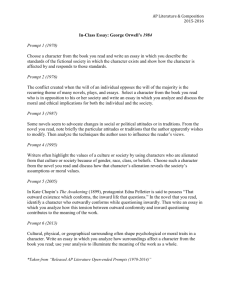LDC Task Template Collection Version 3.0
advertisement
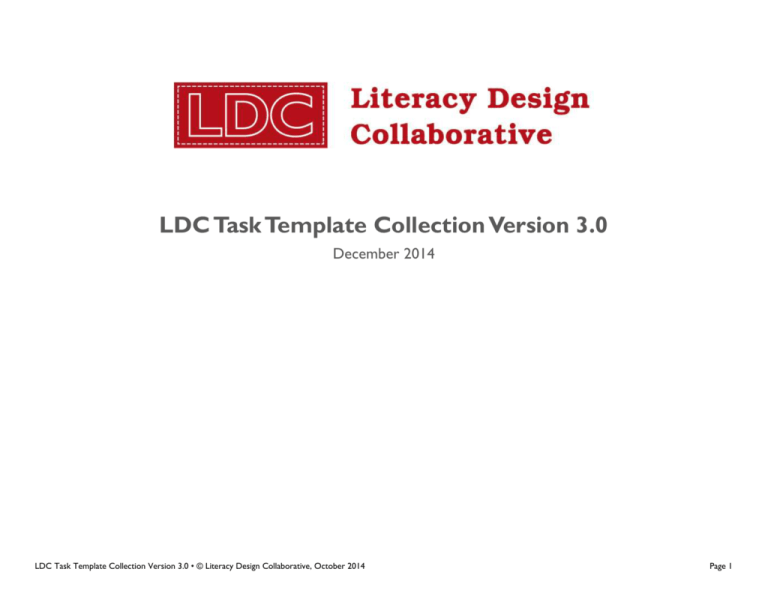
LDC Task Template Collection Version 3.0 December 2014 LDC Task Template Collection Version 3.0 • © Literacy Design Collaborative, October 2014 Page 1 LDC Task Templates for Kindergarten and Grade 1 Cognitive Demand ARGUMENTATION (OPINION) Task IE1: [Insert optional question] After _____ (reading/researching/listening to) ____ (literary text/s and/or informational text/s on _____ content), _____ (write/draw/dictate) _____ (product) in which you define _____ (concept or term) and explain _____ (content). Support your response with evidence from the text/s. Task IE2: [Insert optional question] After _____ (reading/researching/listening to) _____ (literary text/s and/or informational text/s on _____ content), _____ (write/draw/dictate) _____ (product) in which you describe _____ (content). Support your response with evidence from the text/s. 1 Definition 2 Description 3 Explanation Task A3: [Insert optional question] After _____ (reading/researching/listening to) _____ (literary and/or informational text/s on _____ content), _____ (write/draw/dictate) _____ (product) in which you explain _____ (content). Support your opinion with evidence from the text/s. Task IE3: [Insert optional question] After _____ (reading/researching/listening to) _____ (literary and/or informational text/s on _____ content), _____ (write/draw/dictate) _____ (product) in which you explain _____ (content). Support your response with evidence from the text/s. Task IE4: [Insert optional question] After _____ (reading/researching/listening to) _____ (literary and/or informational text/s on _____ content), _____ (write/draw/dictate) _____ (product) in which you discuss _____ (content). Support your response with evidence from the text/s. 4 Analysis 5 Comparison INFORMATIONAL/EXPLANATORY Task A5: [Insert optional question] After _____ (reading/researching/listening to) _____ (literary and/or informational text/s on _____ content), _____ (write/draw/ dictate) _____ (product) in which you compare _____ (content). Support your opinion with evidence from the text/s. Task IE5: [Insert optional question] After _____ (reading/researching/listening to) _____ (literary and/or informational text/s on _____ content), _____ (write/draw/dictate) _____ (product) in which you compare _____ (content). Support your response with evidence from the text/s. Task IE6: [Insert optional question] After _____ (reading/researching/listening to) _____ (literary and/or informational text/s on _____ content), _____ (write/draw/dictate) _____ (product) in which you explain the cause/s of _____ (content) and the effect/s _____ (content). Support your response with evidence from the text/s. 6 CauseEffect Rubrics for Scoring Student Responses to Teaching Tasks for Kindergarten and Grade 1 The Argumentation (Opinion) Rubric and the Informational/Explanatory Rubric for Kindergarten and Grade 1 Teaching Tasks are attached in the Appendix to LDC Task Template Collection Version 3.0. LDC Task Template Collection Version 3.0 • © Literacy Design Collaborative, October 2014 Page 2 LDC Elementary Task Templates for Grades 2–5 Cognitive Demand ARGUMENTATION (OPINION) INFORMATIONAL/EXPLANATORY 1 Definition Task IE1: [Insert optional question] After (reading/researching) _____ (literary text/s and/or informational text/s on _____ content), write _____ (product) in which you define _____ (concept or term) and explain _____ (content). Support your response with evidence from the text/s. 2 Description Task IE2: [Insert optional question] After (reading/researching) _____ (literary text/s and/or informational text/s on _____ content), write _____ (product) in which you describe _____ (content). Support your response with evidence from the text/s. 3 Explanation Task A3: [Insert optional question] After (reading/researching) _____ (literary text/s and/or informational text/s on _____ content), write _____ (product) in which you explain _____ (content). Support your opinion with evidence from the text/s. Task IE3: [Insert optional question] After (reading/researching) _____ (literary text/s and/or informational text/s on _____ content), write _____ (product) in which you explain _____ (content). Support your response with evidence from the text/s. Task IE4: [Insert optional question] After (reading/researching) _____ (literary text/s and/or informational text/s on _____ content), write _____ (product) in which you analyze _____ (content). Support your response with evidence from the text/s. 4 Analysis 5 Comparison Task A5: [Insert optional question] After (reading/researching) _____ (literary text/s and/or informational text/s on _____ content), write _____ (product) in which you compare _____ (content). Support your opinion with evidence from the text/s. Task IE5: [Insert optional question] After (reading/researching) _____ (literary text/s and/or informational text/s on _____ content), write _____ (product) in which you compare _____ (content). Support your response with evidence from the text/s. 6 Cause-Effect Task A6: [Insert optional question] After (reading/researching) _____ (literary text/s and/or informational text/s on _____content), write _____ (product) in which you argue the cause/s of _____ (content) and explain the effect/s _____ (content). Support your opinion with evidence from the text/s. Task IE6: [Insert optional question] After (reading/researching) _____ (literary text/s and/or informational text/s on _____ content), write _____ (product) in which you examine the cause/s of _____ (content) and explain the effect/s _____ (content). Support your response with evidence from the text/s. Task IE7: [Insert optional question] After (reading/researching) _____ (literary text/s and/or informational text/s on _____ content), write _____ (product) in which you relate how _____ (content). Support your response with evidence from the text/s. 7 ProceduralSequential Rubrics for Scoring Student Responses to Teaching Tasks for Grades 2–5 The Argumentation (Opinion) Rubric and the Informational/Explanatory Rubric for Grades 2–5 Teaching Tasks are attached in the Appendix to LDC Task Template Collection Version 3.0. LDC Task Template Collection Version 3.0 • © Literacy Design Collaborative, October 2014 Page 3 LDC Task Templates for Grades 6–12 Cognitive Demand ARGUMENTATION INFORMATIONAL/EXPLANATORY 1 Definition Task IE1: [Insert optional question] After (reading/researching) _____ (literary text/s and/or informational text/s on _____ content), write _____ (product) in which you define _____ (concept or term) and explain _____ (content). Support your discussion with evidence from the text/s. 2 Description Task IE2: [Insert optional question] After (reading/researching) _____ (literary text/s and/or informational text/s on _____ content), write _____ (product) in which you describe _____ (content). Support your discussion with evidence from the text/s. 3 Explanation Task IE3: [Insert optional question] After (reading/researching) _____ (literary text/s and/or informational text/s on _____ content), write _____ (product) in which you explain _____ (content). Support your discussion with evidence from the texts. Task A4: [Insert optional question] After (reading/researching) _____ (literary text/s and/or informational text/s on _____ content), write _____ (product) in which you argue _____ (content). Support your position with evidence from the text/s. Task IE4: [Insert optional question] After (reading/researching) _____ (literary text/s and/or informational text/s on _____ content), write _____ (product) in which you analyze _____ (content). Support your discussion with evidence from the text/s. 5 Comparison Task A5: [Insert optional question] After (reading/researching) _____ (literary and/or informational text/s on _____ content), write _____ (product) in which you compare _____ (content) and argue _____ (content). Support your position with evidence from the text/s. Task IE5: [Insert optional question] After (reading/researching) _____ (literary text/s and/or informational text/s on _____ content), write _____ (product) in which you compare _____ (content). Support your discussion with evidence from the text/s. 6 CauseEffect Task A6: [Insert optional question] After (reading/researching) _____ (literary text/s and/or informational text/s on _____content), write _____ (product) in which you argue the cause/s of _____ (content) and explain the effect/s _____ (content). Support your position with evidence from the text/s. Task IE6: [Insert optional question] After (reading/researching) _____ (literary text/s and/or informational text/s on _____ content), write _____ (product) in which you examine cause/s of _____ (content) and explain the effect/s _____ (content). Support your discussion with evidence from the text/s. 4 Analysis 7 ProceduralSequential LDC Task Template Collection Version 3.0 • © Literacy Design Collaborative, October 2014 Task IE7: [Insert optional question] After (reading/researching) _____ (literary text/s and/or informational text/s on _____ content), write _____ (product) in which you relate how _____ (content). Support your discussion with evidence from the text/s. Page 4 Task IE8: [Insert optional question] After (reading/researching) _____ (informational text/s on _____ content), developing a hypothesis, and conducting an experiment examining _____ (content), write a laboratory report in which you explain your procedures and results and confirm or reject your hypothesis. 8 HypothesisExperiment 9 Evaluation Task A9: [Insert optional question] After (reading/researching) _____ (literary text/s and/or informational text/s on _____content), write _____ (product) in which you discuss _____ (content) and evaluate _____ (content). Support your position with evidence from the text/s. 10 ProblemSolution Task A10: [Insert optional question] After (reading/researching) _____ (literary text/s and/or informational text/s on _____content), write _____ (product) in which you identify a problem _____ (content) and propose a solution. Support your position with evidence from the text/s. Rubrics for Scoring Student Responses to Teaching Tasks for Grades 6–12 The Argumentation Rubric and the Informational/Explanatory Rubric for Grades 6–12 Teaching Tasks are attached in the Appendix to LDC Task Template Collection Version 3.0. LDC Task Template Collection Version 3.0 • © Literacy Design Collaborative, October 2014 Page 5 Optional Demands for Adding Rigor to Teaching Tasks Demands may be added to a teaching task to increase its rigor. You might choose to add either a single demand or multiple demands depending on your students’ needs, grade level standards, or content. Additional demands can also be used as a mechanism to provide additional differentiation for individuals or groups with similar instructional needs. D1 Be sure to acknowledge competing views. (Use with Argumentation tasks.) D2 Give ____ examples from past or current ____ (events; issues) to illustrate and clarify your position. D3 What _____ (lesson/s, conclusion/s, implication/s) can you draw about _____ (content)? D4 In your discussion, address the credibility and origin of sources. D5 Identify any gaps or unanswered questions. D6 Include _____ (bibliography, citations, references, endnotes). D7 Include _____ (charts, tables, illustrations, and/or stylistic devices) to help convey your message to your readers. D8 Explain how _____ (key detail/s, historical events, scientific ideas or concepts, or steps in a technical procedure) and _____ (key detail/s, historical events, scientific ideas or concepts, or steps in a technical procedure) are _____ (connected or related). D9 Include a _____ (retelling, recounting, summary) in your response. (Use with K–1 and 2–5 tasks.) D10 Include _____ (specific or #) _____ (key detail/s or example/s) from the text/s in your response. (Use with K–1 and 2–5 tasks.) D11 Connect _____ (content) and _____ (content) in your response. (Use with K–1 and 2–5 tasks.) LDC Task Template Collection Version 3.0 • © Literacy Design Collaborative, October 2014 Page 6 Appendix: Argumentation (Opinion) Rubric for Kindergarten and Grade 1 Teaching Tasks Scoring Elements Focus Controlling Idea Reading/ Research (when applicable) Development Organization Not Yet 1 1.5 Approaches Expectations 2 2.5 Meets Expectations 3 3.5 Advanced 4 Attempts to address prompt but lacks focus or is off task. D: Attempts to address additional demands but lacks focus or is off task. Addresses prompt and provides a position but focus is uneven. D: Addresses additional demands superficially. Addresses prompt appropriately with a steady focus and provides a position; stays on task. D: Addresses additional demands sufficiently. Addresses all aspects of prompt with a strong focus and provides convincing position; stays on task. D: Addresses additional demands with thoroughness and makes a connection to opinion or claim. Lacks a preference, opinion, or claim. States a preference, opinion, or claim. States a credible preference, opinion, or claim. States and maintains a credible preference, opinion, or claim. Provides information not connected or relevant to the reading materials or purpose of the prompt. Provides details from reading materials relevant to the purpose of the prompt but lacks accuracy. Accurately provides details from reading materials that support the preference, opinion, or claim. Accurately and effectively provides key details from reading materials that support the preference, opinion, or claim. Lacks reasons that support preference, opinion, or claim. Provides reasons that support the preference, opinion, or claim. Lacks organization of ideas. Attempts to organize ideas. Provides sufficient reasons that support the preference, opinion, or claim. Demonstrates some elements of organization: including an introduction of topic or book, supporting reasons, and/or closure or a concluding statement or section. Provides sound reasons and key details that support the preference, opinion, or claim. Demonstrates elements of organization: including an introduction of topic or book, supporting reasons, and closure or a concluding statement or section. Attempts to apply gradeDemonstrates an uneven Demonstrates a command of gradeDemonstrates and maintains a wellappropriate conventions of standard English* but lacks command of gradeappropriate standard English developed command of gradeConventions cohesion and control of appropriate conventions of conventions, with few errors, as appropriate conventions of grammar, usage, and standard English.* appropriate to grade level.* standard English, with few errors.* mechanics. Content is irrelevant, Shows basic or uneven Presents generally accurate Presents relevant and accurate Content inappropriate, or understanding of topic or understanding of topic or disciplinary content to demonstrate Understanding inaccurate. disciplinary content. disciplinary content. in-depth understanding. * “Grade-appropriate conventions of standard English” means grade-level CCSS language standards that are appropriate to time of year and student’s language development stage. LDC Task Template Collection Version 3.0 • © Literacy Design Collaborative, October 2014 Page 7 Appendix: Informational/Explanatory Rubric for Kindergarten and Grade 1 Teaching Tasks Scoring Elements Not Yet 1 1.5 Approaches Expectations 2 2.5 Meets Expectations 3 3.5 Advanced 4 Focus Attempts to address prompt but lacks focus or is off task. D: Attempts to address additional demands but lacks focus or is off task. Addresses prompt but focus is uneven. D: Addresses additional demands superficially. Addresses prompt appropriately with a steady focus; stays on task. D: Addresses additional demands sufficiently. Addresses all aspects of prompt with a developed and consistent focus; stays on task. D: Addresses additional demands with thoroughness and makes a connection to controlling idea. Controlling Idea Lacks a clear topic or controlling idea. Names a topic or controlling idea, though may lack clarity or credibility. Names a credible topic or controlling idea. Names and maintains a strong and credible topic or controlling idea. Reading/ Research (when applicable) Provides details not connected to the reading materials or to the prompt. Provides some details from reading materials but lacks accuracy or relevance. Accurately provides some details from reading materials relevant to the prompt. Accurately and effectively provides key details from reading materials relevant to the prompt. Provides appropriate details that Provides key details that strongly support the focus and controlling support the focus and controlling idea. idea. Demonstrates some elements of Demonstrates elements of organization: including an introduction organization: including an Lacks organization of Attempts to organize topic of topic, supporting details, and/or introduction, supporting details, and Organization topic and information. and information. closure or a concluding statement or closure or a concluding statement or section. section. Lacks control of Demonstrates a command of Demonstrates and maintains a wellDemonstrates an uneven grammar, usage, and command of standard standard English conventions, with developed command of standard Conventions mechanics appropriate English conventions few errors, as appropriate to grade English conventions, with few errors, to grade level.* appropriate to grade level.* level.* as appropriate to grade level.* Content is irrelevant, Shows uneven Presents generally accurate Presents relevant and accurate Content inappropriate, or understanding of topic or understanding of topic or disciplinary disciplinary content to enhance Understanding inaccurate. disciplinary content. content. understanding of topic. * “Grade-appropriate conventions of standard English” means grade-level CCSS language standards that are appropriate to time of year and student’s language development stage. Development Does not provide details or is off task. Provides some details that support the focus and controlling idea. LDC Task Template Collection Version 3.0 • © Literacy Design Collaborative, October 2014 Page 8 Appendix: Argumentation (Opinion) Rubric for Grades 2–5 Teaching Tasks Scoring Elements Focus Controlling Idea Reading or Research Development Organization Not Yet 1 Attempts to address prompt but lacks focus or is off task. D: Attempts to address additional demands but lacks focus or is off task. Attempts to establish an opinion or claim but lacks a clear purpose. Attempts to provide information from reading materials but lacks connections or relevance to the prompt. Attempts to provide details in response to the prompt but lacks sufficient development or relevance to the prompt. Attempts to organize ideas but lacks control of structure. Approaches Expectations 1.5 2 Meets Expectations 2.5 3 Advanced 3.5 4 Addresses prompt appropriately but with weak or uneven focus. D: Addresses additional demands superficially. Addresses prompt appropriately and maintains a clear, steady focus; stays on task. Provides a generally convincing position. D: Addresses additional demands sufficiently. Addresses all aspects of prompt appropriately and maintains a strongly developed focus and convincing position; stays on task. D: Addresses additional demands with thoroughness and makes a connection to opinion or claim. Establishes an opinion or claim. Establishes a credible opinion or claim. Establishes and maintains a substantive and credible opinion or claim. Provides some details from reading materials relevant to the prompt with minor lapses in accuracy or completeness. Accurately provides details from reading materials relevant to the prompt that support opinion or claim. Accurately and effectively provides concrete details from reading materials to support opinion or claim. Provides appropriate details to support and develop the focus, opinion, or claim with minor lapses in the reasoning, examples, or explanations. Provides appropriate and sufficient details to support and develop the focus, opinion, or claim. Provides sound reasoning and detailed information to effectively support and develop the focus, opinion, or claim. Uses an organizational structure to develop reasoning and logic, with minor lapses in structure or coherence. Organizational structure adequately supports and reveals the reasoning and logic of the opinion or claim. Maintains an organizational structure intentionally and effectively. Structure enhances development of the reasoning and logic of the opinion or claim. Shows well-developed command of cohesion and grade-appropriate conventions of standard English* with few errors. Uses language and tone consistently appropriate to audience, purpose, and specific requirements of the prompt. Lists sources using appropriate format. Shows uneven command of Shows command of cohesion and cohesion and grade appropriate grade-appropriate conventions of conventions of standard standard English* with few errors. English.* Uses language and Uses language and tone Conventions tone with some inaccurate, appropriate to audience, purpose, inappropriate, or uneven and specific requirements of the features. Inconsistently lists prompt. Lists sources with only sources. minor errors. Attempts to include Briefly notes disciplinary disciplinary content in content relevant to the Accurately presents disciplinary Integrates relevant and accurate Content opinion or claim but prompt; shows basic or uneven content relevant to the prompt disciplinary content with thorough Understanding understanding of content is understanding of disciplinary with sufficient explanations that explanations that demonstrate inweak; content is irrelevant, content; minor errors in demonstrate understanding. depth understanding. inappropriate, or inaccurate. explanation. * “Grade-appropriate conventions of standard English” means grade-level CCSS language standards that are appropriate to time of year and student’s language development stage. Attempts to apply gradeappropriate conventions of standard English* but lacks cohesion and control of grammar, usage, and mechanics. Does not list sources. LDC Task Template Collection Version 3.0 • © Literacy Design Collaborative, October 2014 Page 9 Appendix: Informational/Explanatory Rubric for Grades 2–5 Teaching Tasks Scoring Elements Not Yet 1 Approaches Expectations 1.5 2 Meets Expectations 2.5 3 Advanced 3.5 4 Focus Attempts to address prompt but lacks focus or is off task. D: Attempts to address additional demands but lacks focus or is off task. Addresses prompt appropriately but with a weak or uneven focus. D: Addresses additional demands superficially. Addresses prompt appropriately and maintains a clear, steady focus; stays on task. D: Addresses additional demands sufficiently. Addresses all aspects of prompt appropriately and maintains a strongly developed focus; stays on task. D: Addresses additional demands with thoroughness and makes a connection to controlling idea. Controlling Idea Attempts to establish a controlling idea but lacks a clear purpose. Establishes a controlling idea with a general purpose, though may lack clarity or credibility. Establishes a credible controlling idea with a clear purpose maintained throughout the response. Establishes a strong controlling idea with a clear purpose maintained throughout the response. Attempts to present information from reading materials but lacks connections or relevance to the prompt. Attempts to provide details in response to the prompt, including retelling but lacks sufficient development or relevancy. Presents some information from reading materials relevant to the prompt with minor lapses in accuracy or completeness. Accurately presents sufficient details from reading materials relevant to the purpose of the prompt. Accurately and effectively presents information and concrete details from reading materials that are relevant to all parts of the prompt. Presents appropriate details to support the focus and controlling idea. Presents appropriate and sufficient details to support the focus and controlling idea. Presents thorough and concrete details to strongly support the focus and controlling idea. Reading/ Research (when applicable) Development Organization Attempts to organize ideas but lacks control of structure. Uses an appropriate structure to address the specific requirements of the prompt, with minor lapses in coherence and/or structure. Maintains an appropriate organizational structure to address the specific requirements of the prompt, including an introduction of topic, supporting details, and/or a concluding statement or section. Shows command of cohesion and grade-appropriate conventions of standard English* with few errors. Uses language and tone appropriate to audience, purpose, and specific requirements of the prompt. Lists sources with only minor errors. Maintains an organizational structure that intentionally and effectively enhances the presentation of information as required by the specific prompt. Shows uneven command of Shows well-developed command of cohesion and grade appropriate cohesion and grade-appropriate conventions of standard conventions of standard English* with English.* Uses language and few errors. Uses language and tone Conventions tone with some inaccurate, consistently appropriate to audience, inappropriate, or uneven purpose, and specific requirements of features. Inconsistently lists the prompt. Lists sources using sources. appropriate format. Briefly notes disciplinary Attempts to include Accurately presents disciplinary Integrates relevant and accurate content relevant to the disciplinary content but Content prompt; shows basic or uneven content relevant to the prompt disciplinary content with thorough understanding of content is Understanding understanding of disciplinary with sufficient explanations that explanations that demonstrate inweak; content is irrelevant, content; minor errors in demonstrate understanding. depth understanding. inappropriate, or inaccurate. explanation. * “Grade-appropriate conventions of standard English” means grade-level CCSS language standards that are appropriate to time of year and student’s language development stage. Attempts to apply gradeappropriate conventions of standard English* but lacks cohesion and control of grammar, usage, mechanics, language and tone. Does not list sources. LDC Task Template Collection Version 3.0 • © Literacy Design Collaborative, October 2014 Page 10 Appendix: Argumentation Rubric for Grades 6–12 Teaching Tasks Scoring Elements Focus Controlling Idea Reading/ Research Development Organization Not Yet 1 Attempts to address prompt but lacks focus or is off task. D: Attempts to address additional demands but lacks focus or is off task. Attempts to establish a claim but lacks a clear purpose. Attempts to reference reading materials to develop response but lacks connections or relevance to the purpose of the prompt. Attempts to provide details in response to the prompt but lacks sufficient development or relevance to the purpose of the prompt. Content Understanding Addresses prompt appropriately and establishes a position but focus is uneven. D: Addresses additional demands superficially. Establishes a claim. Presents information from reading materials relevant to the purpose of the prompt with minor lapses in accuracy or completeness. Presents appropriate details to support and develop the focus, controlling idea, or claim, with minor lapses in the reasoning, examples, or explanations. 2.5 Meets Expectations 3 Addresses prompt appropriately and maintains a clear, steady focus. Provides a generally convincing position. D: Addresses additional demands sufficiently Establishes a credible claim. Accurately and effectively presents important details from reading materials to develop argument or claim. Presents appropriate and sufficient details to support and develop the focus, controlling idea, or claim. Presents thorough and detailed information to effectively support and develop the focus, controlling idea, or claim. Maintains an appropriate organizational structure to address specific requirements of the prompt. Structure reveals the reasoning and logic of the argument. citation. Demonstrates an uneven command of standard English conventions and cohesion. Uses language and tone with some inaccurate, inappropriate, or uneven features. Inconsistently cites sources. Demonstrates a command of standard English conventions and cohesion with few errors. Response includes language and tone appropriate to the audience, purpose, and specific requirements of the prompt. Cites sources using appropriate format with only minor errors. Attempts to include disciplinary content in argument but understanding of content is weak; content is irrelevant, inappropriate, or inaccurate. Briefly notes disciplinary content relevant to the prompt; shows basic or uneven understanding of content; minor errors in explanation. Accurately presents disciplinary content relevant to the prompt with sufficient explanations that demonstrate understanding. Attempts to organize ideas but lacks control of structure. but lacks cohesion and control of grammar, usage, mechanics, language and tone. Sources are used without LDC Task Template Collection Version 3.0 • © Literacy Design Collaborative, October 2014 3.5 Advanced 4 Addresses all aspects of prompt appropriately with a consistently strong focus and convincing position. D: Addresses additional demands with thoroughness and makes a connection to claim. Establishes and maintains a substantive and credible claim or proposal. Accurately presents details from reading materials relevant to the purpose of the prompt to develop argument or claim. Uses an appropriate organizational structure for development of reasoning and logic, with minor lapses in structure and/or coherence. Attempts to demonstrate standard English conventions Conventions 1.5 Approaches Expectations 2 Maintains an organizational structure that intentionally and effectively enhances the presentation of information as required by the specific prompt. Structure enhances development of the reasoning and logic of the argument. Demonstrates and maintains a welldeveloped command of standard English conventions and cohesion with few errors. Response includes language and tone consistently appropriate to the audience, purpose, and specific requirements of the prompt. Consistently cites sources using appropriate format. Integrates relevant and accurate disciplinary content with thorough explanations that demonstrate in-depth understanding. Page 11 Appendix: Informational/Explanatory Rubric for Grades 6–12 Teaching Tasks Scoring Elements Not Yet 1 Attempts to address prompt but lacks focus or is off task. D: Attempts to address additional demands but lacks focus or is off task. 1.5 Approaches Expectations 2 2.5 Meets Expectations 3 3.5 Advanced 4 Addresses all aspects of prompt appropriately and maintains a strongly developed focus. D: Addresses additional demands with thoroughness and makes a connection to controlling idea. Establishes a strong controlling idea with a clear purpose maintained throughout the response. Addresses prompt appropriately but with a weak or uneven focus. D: Addresses additional demands superficially. Addresses prompt appropriately and maintains a clear, steady focus. D: Addresses additional demands sufficiently. Establishes a controlling idea with a general purpose. Establishes a controlling idea with a clear purpose maintained throughout the response. Presents information from reading materials relevant to the purpose of the prompt with minor lapses in accuracy or completeness. Presents information from reading materials relevant to the prompt with accuracy and sufficient detail. Accurately presents information relevant to all parts of the prompt with effective selection of sources and details from reading materials. Presents appropriate details to support the focus and controlling idea. Presents appropriate and sufficient details to support the focus and controlling idea. Presents thorough and detailed information to strongly support the focus and controlling idea. Attempts to organize ideas but lacks control of structure. Uses an appropriate organizational structure to address the specific requirements of the prompt, with some lapses in coherence or awkward use of the organizational structure Maintains an appropriate organizational structure to address the specific requirements of the prompt. Maintains an organizational structure that intentionally and effectively enhances the presentation of information as required by the specific prompt. Conventions Attempts to demonstrate standard English conventions but lacks cohesion and control of grammar, usage, and mechanics. Sources are used without citation. Demonstrates an uneven command of standard English conventions and cohesion. Uses language and tone with some inaccurate, inappropriate, or uneven features. Inconsistently cites sources. Demonstrates a command of standard English conventions and cohesion with few errors. Response includes language and tone appropriate to the audience, purpose, and specific requirements of the prompt. Cites sources using an appropriate format with only minor errors. Demonstrates and maintains a welldeveloped command of standard English conventions and cohesion with few errors. Response includes language and tone consistently appropriate to the audience, purpose, and specific requirements of the prompt. Consistently cites sources using an appropriate format. Content Understanding Attempts to include disciplinary content in explanations but understanding of content is weak; content is irrelevant, inappropriate, or inaccurate. Briefly notes disciplinary content relevant to the prompt; shows basic or uneven understanding of content; minor errors in explanation. Accurately presents disciplinary content relevant to the prompt with sufficient explanations that demonstrate understanding. Integrates relevant and accurate disciplinary content with thorough explanations that demonstrate in-depth understanding. Focus Controlling Idea Reading/ Research Development Organization Attempts to establish a controlling idea but lacks a clear purpose. Attempts to present information in response to the prompt but lacks connections or relevance to the purpose of the prompt. Attempts to provide details in response to the prompt, including retelling but lacks sufficient development or relevancy. LDC Task Template Collection Version 3.0 • © Literacy Design Collaborative, October 2014 Page 12
